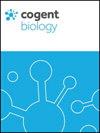The effect of ascorbic acid on bone cancer cells in vitro
引用次数: 18
Abstract
Abstract Ascorbic acid (Vitamin C) has long been known for its anti-cancer properties and in the present study the effects of ascorbic acid (AsA) on osteogenic differentiation, apoptosis, and signaling pathways of the human G29 osteosarcoma cell line were studied. The expression of Runt-related transcription factor-2 (RUNX2) and osteocalcin genes were evaluated by real-time polymerase chain reaction (PCR). Osteoblastic maturation was assessed with alkaline phosphatase activity and mineralization with alizarin red deposition, and apoptosis with a caspase-2 apoptotic assay as well as the cell viability via the cytotoxicity assay. The possible role of the MAP kinase pathway (p44/42, p38, and p-JNK signaling pathway) was also studied. Our results showed that RUNX2 and osteocalcin gene expression, mineralization, cell viability, and metabolic activity levels were increased in cells treated with low concentrations of AsA with respect to untreated cells. At higher concentrations, AsA resulted in decreases in these parameters and induced apoptosis of the G292 osteosarcoma cells via downregulation of the MAPK pathway. The findings presented here support the ability of AsA to modulate the viability and differentiation of the G292 type of bone cancer cell with increases or decreases depending on the AsA concentration suggesting a need for further evaluation of the possible use of this vitamin in the regulation of bone cell cancer growth.抗坏血酸对体外骨癌细胞的影响
抗坏血酸(维生素C)因其抗癌特性而闻名,本研究研究了抗坏血酸(AsA)对人G29骨肉瘤细胞系成骨分化、细胞凋亡和信号通路的影响。实时聚合酶链反应(real-time polymerase chain reaction, PCR)检测runt相关转录因子-2 (RUNX2)和骨钙素基因的表达。通过碱性磷酸酶活性和茜素红沉积的矿化来评估成骨细胞的成熟,通过caspase-2凋亡实验来评估细胞凋亡,通过细胞毒性实验来评估细胞活力。还研究了MAP激酶通路(p44/42、p38和p-JNK信号通路)的可能作用。我们的研究结果显示,与未处理的细胞相比,低浓度AsA处理的细胞中RUNX2和骨钙素基因表达、矿化、细胞活力和代谢活性水平均有所增加。在较高浓度下,AsA导致这些参数降低,并通过下调MAPK通路诱导G292骨肉瘤细胞凋亡。本文的研究结果支持AsA调节G292型骨癌细胞的活力和分化的能力,其增加或减少取决于AsA浓度,这表明需要进一步评估这种维生素在骨细胞癌生长调节中的可能使用。
本文章由计算机程序翻译,如有差异,请以英文原文为准。
求助全文
约1分钟内获得全文
求助全文

 求助内容:
求助内容: 应助结果提醒方式:
应助结果提醒方式:


